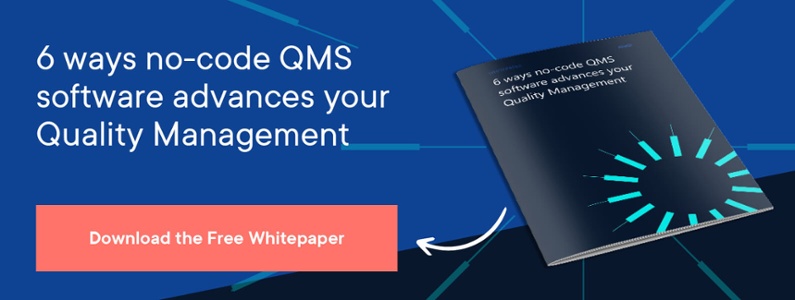You hear a good deal about no-code advantages, including speedy deployment, lower costs, increased flexibility, as well as the fact that it requires limited IT resources. But despite these benefits, there are also multiple fears associated with implementing and maintaining a no-code QMS. This article looks at some common fears about no-code solutions and helps you decide if it’s the right choice for your company.
No-Code QMS: is it for you?
To begin with, it may be of some use to establish exactly what a no-code QMS is. Firstly, no-code is distinct from low-code. Low-code is typically intended for developers to quickly create an application based on an application framework. No-code requires no IT skills and allows non-developers to build applications.
Secondly, it’s important to understand that— yes— both still involve code. Code always exists within software. However, with low-code and no-code, the end-user or business implementing QMS software has to touch only limited code or, in the case of the latter, no code at all. In the QMS context, this means that the Quality department can implement and maintain a no-code system themselves.
Choosing no-code, the Quality team is not only involved but taking the steering wheel. Starting with implementation, they lead the project and tailor the system to their needs and organizational requirements.
Is no-code too simplistic then?
While steering away from complex implementations sounds great for most manufacturers, some businesses might ask themselves if this approach may be too simplistic. Or even whether they’ll get stuck with a solution that forces them to bend to its demands. The answer is no, not at all.
No-code supports rich functionality and comes with increased flexibility. Especially in the context of a top-tier no-code QMS such as AlisQI, organizations will need to implement one single, integrated platform for Quality Control, Quality Assurance, and QESH instead of multiple systems.
Will a no-code QMS bind you to the vendor?
No-code can be transformative because it allows quality teams to implement and use their QMS independent of the vendor, a consultant, or their own (often overstretched) IT department.
When evaluating vendors, it’s best to take the time to understand the value of their solution, its robustness, and its perks. This is not only in regard to customizations but also when onboarding new users.
Will no-code lock us into certain processes?
Deploying a no-code platform is in fact the best response to lock-in concerns. You can import historical data in minutes, gain immediate insights into quality trends, and data can always be exported.
Furthermore, you can easily mold the system to your existing business processes. With a no-code QMS such as AlisQI, you can easily define your own quality processes through these easy-to-use, editable building blocks:
- Forms and business logic
- Workflows and alerts
- Models
- Analytics (including reports, charts, and dashboards)
You can always revert and adjust your processes or start over.
Isn’t no-code best for particular, narrow applications?
Not at all. Most no-code solutions now cater to enterprises, providing answers that work across a company – and connect several plants. No-code today is meant to be a holistic solution, and a great first step to automating processes. It gives manufacturers full flexibility, access to data, and the possibility to turn that data into insights.
Can we be part of the implementation process with no-code?
One central principle in no-code QMS is inclusivity— its very intent is to streamline software to make it accessible to everyone. Implementation should not be a siloed process exclusive to your vendor or IT department. In fact, it should be a collaborative process in which end users take the lead. Early involvement builds confidence, user engagement and will ultimately provide you with the best tailored solution.
You can learn more about just how dynamic the possibilities are when no-code and QM come together by requesting a demo today.

No-code Quality Management
While technological change is accelerating, the capacity to absorb this change becomes a bottleneck for many manufacturers. No-code Quality Management Software helps to eliminate this bottleneck.
Learn how no-code quality management can benefit your business.
Download whitepaper

